

Discover more from Fast Women
Issue 258, sponsored by New Balance
Tigst Assefa destroys the marathon world record in Berlin
Halfway through the Berlin Marathon, it looked like Ethiopia’s Tigst Assefa was off to an aggressive start, as she split 1:06:20, 42 seconds ahead of world record pace. But she was just getting warmed up. She picked up the pace after 25K and covered the second half of the race in 1:05:33. Her winning time, 2:11:53, took two minutes, 11 seconds off of Brigid Kosgei’s previous world record (2:14:04, Chicago 2019).
“I knew I wanted to go for the world record but I never thought I would do this time,” Assefa said after the race. “It was the result of hard work.”
The world record was due for an upgrade. As shoe technology has improved and the sport has moved forward, women have been rewriting the distance world records at shorter distances. Despite being less than four years old, the marathon record was the oldest (outdoor) record in a frequently-run distance.
But with a single race, Assefa catapulted women’s marathoning into a new realm. She averaged 5:01 per mile, won the race by nearly six minutes, and entirely skipped over the 2:13s and 2:12s. Her time would have won the first 11 editions of this race, which began in 1974, outright. Assefa’s split over the last 2.195K of the race was only four seconds slower than that of men’s winner Eliud Kipchoge.
The World Athletics scoring tables attempt to determine equivalent performances across track & field and road running events, among other things. The data must be taken with a grain of salt, but according to the tables, Assefa’s performance, worth 1,318 points, is now the strongest world record in a women’s running event. It surpassed Florence Griffith-Joyner’s 10.49 100m (1,314 points) and 21.34 200m (1,308 points), Sydney McLaughlin-Levrone’s 50.68 in the 400m hurdles (1,312 points), Marita Koch’s 47.60 400m (1,304 points), Letesenbet Gidey’s 29:01.03 10,000m (1,303 points), and Faith Kipyegon’s 3:49.11 1500m (1,295 points).
Aside from the final minute of the race, Assefa ran with one or more male pacesetters throughout. Early on, she had other women around her, as a pack of 13 went through 10K around 31:45, ahead of world record pace. By 15K, Assefa and Workenesh Edesa, also of Ethiopia, had broken away, but in the 17th kilometer, Assefa dropped Edesa, too. The rest of the race was just Assefa and her pacers against the clock.
Despite the near-perfect conditions, the rest of the field paid for their fast early pace. Kenya’s Sheila Chepkirui was hurting at the finish, but she hung on better than anyone else to take second in 2:17:49. Magdalena Shauri had run 1:06:37 in the half, but she had a huge marathon breakthrough here, lowering her personal best by nearly 15 minutes, destroying the Tanzanian record, and taking third in 2:18:41. The top eight women broke 2:20. (Results)
Despite representing Ethiopia in the 800m at the 2016 Olympic Games (her PR is 1:59.24), Assefa didn’t really burst onto the international racing scene until her shocking win at last year’s Berlin Marathon, in 2:15:37. This Runner’s World piece from last year has some of the details on Assefa’s background.
Between her wins in Berlin, Assefa raced only once, winning the Bahrain Royal Night Half Marathon last December in 1:07:40. She was scheduled to run April’s London Marathon, but she pulled out due to injury. Despite her marathon success, much of her story is still a mystery. Even basic details have been hard to come by. Case in point: For the past year, she’s been known as Tigist, but her agent told Jonathan Gault that it’s actually Tigst, and she is 26 years old, after being listed as 28 last year. Her World Athletics profile now reflects those changes. This Instagram profile, which seems to be either run by her or on her behalf, has her name as Tigist, though.
Being a fan of elite distance running in recent years has required a complete recalibration of what a fast time is. With any leap forward of this magnitude, there’s sure to be discussion of performance-enhancing drugs. It’s unfortunately impossible to say who is or isn’t doping. To be a fan of the sport, I need to trust that the anti-doping agencies are doing their job, or that they’re at least trying. (I think they need to do a lot more, but speculating about who is or isn’t clean is unproductive.)
Improved shoe technology is most likely to make a bigger difference the longer the event. It’s possible that Assefa’s performance is stronger than any other women’s world record in the running events, but it’s also possible that the World Athletics scoring tables need to be adjusted to account for changes to shoe technology.
It will be interesting to see if Assefa’s run spurs other incredible performances in the marathon, or if this one stands for a long time. Marathon records tend to last a bit longer, because there are only so many times a year that perfect pacing meets fantastic fitness, a fast course, and excellent weather conditions.
Annie Frisbie was the top U.S. runner in the field, taking 17th in 2:27:02. Frisbie did it the hard way, going out at 2:22 marathon pace and fading in the second half. But she still finished less than a minute off of her PR. Jacqueline Gaughan finished 18th in 2:27:08 and took 4:30 off her PR. Gaughan ran 2:34:37 in her marathon debut in January, improved to 2:31:38 at the Ottawa Marathon in May, and made another leap here. She hit halfway in 1:14:30 and ran a nice negative split, with a 1:12:38 second half. Jane Bareikis also PRed, taking 21st in 2:29:00.
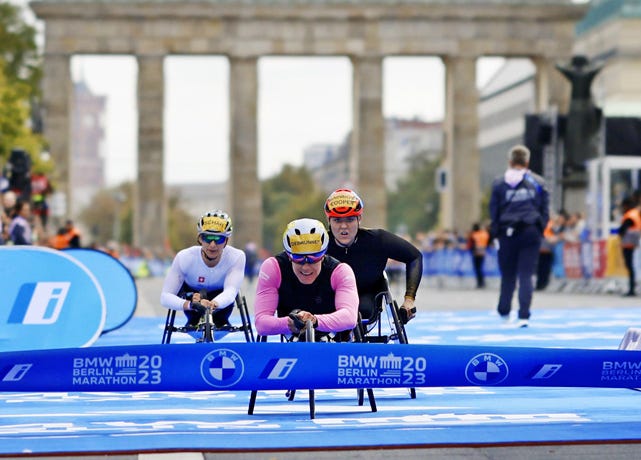
Additional Berlin Notes
Assefa wasn’t the only woman to set a world record on Sunday. Switzerland’s Catherine Debrunner won the wheelchair race in 1:34:16, breaking Manuela Schär’s previous world record of 1:35:42. And she had company. Great Britain’s Eden Rainbow Cooper (second, 1:34:17) and Schär (third, 1:34:17) finished one second back, and Susannah Scaroni took fourth in 1:34:31, only 15 seconds back.
In the latter stages of the race, Assefa wound up running alongside U.S. Olympian Jared Ward, who kicked ahead to beat her by nine seconds. Ward said that Assefa catching him gave him a second wind. I appreciated his post about how it all played out, and his thought process, which included not wanting to interfere with her race.
Assefa’s 5K splits were: 15:59, 15:46, 15:41, 15:26, 15:48, 15:32, 15:29, and 15:32, then she ran 4:53 pace between 40K and the finish (for 1.36 miles).
Pending ratification, Ethiopian women now hold the world records in the 5,000m, 10,000m, half marathon, and marathon. They also took seven out of the top 10 spots in Sunday’s race.
There’s been some buzz around the Adidas shoes that Assefa wore during her record breaking run. They’re lighter than most, and at (a ridiculous) $500 a pair, also more expensive. Other athletes wore the shoes on Sunday and didn’t break records, so the athlete wearing them makes a big difference.
After some bad luck with making it to marathon starting lines, Charlotte Purdue had a strong run in Berlin, finishing ninth in 2:22:17. That makes her the second-fastest British marathoner of all time, and she easily surpassed the Olympic standard (2:26:50).
Canada’s Malindi Elmore, 43, was the top masters finisher, taking 13th overall in 2:23:30, an 80-second personal best. Elmore was already the second-fastest Canadian marathoner of all time, but she moved closer to record holder Natasha Wodak (2:23:12) and also got her Olympic standard out of the way.
Other top U.S. finishers included Katie Kellner (2:32:48), Lily Anderson (2:36:23), Theresa Hailey (2:37:07), Caroline Williams (2:38:44), and Carrie Mack (2:39:14). Anderson was the only new qualifier for the U.S. Olympic Marathon Trials.
Dani Jones finishes her season on a roll
This feature is sponsored by New Balance.
Roughly 150 meters into a physical 1500m final at July’s USATF Outdoor Championships, Dani Jones was “flat tired”—a competitor accidentally stepped on the back of her shoe, removing it partway. Jones continued to run, first with her shoe halfway on, and then with only one shoe. But with two laps to go, she opted to cut her losses and step off the track. She didn’t see herself making the world championship team with only one shoe, and she didn’t want to ruin the rest of her season by trying.
It was an extremely frustrating ending to what should have been the biggest race of her season. She went home to regroup for a bit. “That’s the kind of disappointment you need to address and let yourself be sad about for a little bit,” she told Fast Women. And when she was ready to rebound, she did so in a big way, running three personal bests in a row.
First she won the 1500m at the Ed Murphey Classic, running 4:02.83 and taking 1.43 seconds off her personal best, which had stood for more than two years. Two weeks later, she finished a close second to fellow New Balance athlete Emily Mackay at the Falmouth Mile, running 4:24.17 despite windy conditions. And in her final track race of the season, she finished eighth in the Xiamen Diamond League 1500m. She ran 4:01.66, dipped under the Olympic standard, and took another 1.17 seconds off her personal best, despite getting sick on her way to China.
While Jones, 27, knows that things are never going to be perfect, she says this season included an unusual number of freak occurrences. At the beginning of the season, she got poison ivy or poison oak all over her body. How did she get it? “I mean honestly probably peeing in a bush somewhere,” she said. As a professional athlete who could be drug tested at any time, Jones couldn’t use steroids to ease her suffering, so she waited it out for two weeks. And during her next two races, she raced in a uniform that offered a little more coverage than usual, so no one would be alarmed by her rash.
When the pandemic shut down college racing, and most of the world, in 2020, Jones, a four-time NCAA champion, decided to forgo her remaining collegiate eligibility and join Team Boss, founded by coach Joe Bosshard and his wife, Emma Coburn. Though there were a lot of challenges during that time, Jones now looks back on that period in her life fondly. “I met everyone in a year where they were upset that things were canceled, but it was also a stress-free year, because there wasn’t anything going on,” she said. “We were just training to get ready for the next year. It was super laid back and it was a lot of fun.”
Jones announced that she was signing with New Balance at the end of 2020, and in 2021, she had a solid first full year as a pro and rewrote most of her PRs. But 2022 was her toughest year yet. She still doesn’t know exactly what caused her struggles. Some assumed it was Covid, but doctors were unable to say for sure. She just knows that during the outdoor season, she was hitting a wall during her races, which made her feel like she was going to pass out. After picking up an injury, she decided to end her season in June, and she took an extended break.
Coming back from that was tough, but her 2023 season was a big step in the right direction. “What was really cool about the end of this year was that I just started to feel like racing was actually really fun,” she said. “I kind of forgot that because [last] year, it was so hard, and I felt so bad and so out of it afterwards. It was kind of scary. So it’s been nice to start to feel like myself again.”
Jones is currently taking some down time, as most professional runners do at the end of the season. She still runs for 30 minutes here and there, so her muscles and tendons are ready when it’s time to ramp up her training again. She’s using the time to see family members and spend time with her boyfriend, because they’re in a distance relationship.
In general, it’s a time to be less regimented than she is during the season. “If I don’t want to take a nap, I don’t,” she said. “If I feel like staying up late and sleeping in, I do. I definitely give myself more freedom and go by feel as far as doing the things I need to do during the season.” And more than anything, it’s a mental break.
Jones is also planning some marathon spectating this fall, while her training is less intense. She’ll watch her former University of Colorado teammate Makena Morley run the Twin Cities 10 Mile, held in conjunction with the Twin Cities Marathon, she’ll cheer her teammates on at the Chicago Marathon a week later, and she hopes to be at the New York City Marathon as well, to watch her sister run. Though Jones is a 1500m specialist for now, she would like to end her career running marathons.
Though the offseason is a time to relax a bit and have some fun, as a pro, Jones has come to recognize the importance of prioritizing her happiness year-round. She enjoys off-the-track activities with her teammates, and makes sure to see her other friends in Colorado as well. It helps having more experienced teammates, who share their wisdom.
“Emily Infeld said on a run the other day that even in the years she’s made teams, it hasn’t necessarily always contributed to her happiness,” Jones said. “I think it’s important to remember that our success doesn’t necessarily mean happiness. I’ve had a lot of high highs and low lows as a pro. I’ve had full years where I’m just not doing very well. Stuff like that makes you realize what’s important. When I look back on my time as a pro, I think I’m going to remember the people and the places I went, so I want to take advantage of those things and make sure I’m enjoying myself, [regardless of] results.”
Jones said she looked up to many of the women who are now her teammates when she was in high school and college, and she still has moments where she can’t believe she’s now training with them. And she says that the positive team environment is the real deal.
“I think it’s easy for teams to act like they’re friends on social media but it is truly how Team Boss is,” she said. “It’s a supportive and friendly environment. I get so much out of not even just training with these women but also seeing how they carry themselves at meets and with media and on social media. I think it’s important to have people around you that are better than you and who have lived more than you. It’s had a huge part of my success from college to now.”
Thanks to New Balance for supporting Fast Women this month!
I always enjoy hearing which shoes athletes use for various types of running, so I asked Dani Jones for her New Balance shoe lineup. Like so many, her go-to daily trainer, which she uses on easy runs, is the Fresh Foam X 880v13. It’s a Jones family favorite. Her mom, sister, and grandfather all run and/or walk in the 880s.
Jones races in the FuelCell MD-X v2 and says it’s the best spike she’s ever run in. She rarely works out in the MD-X, but that’s just a matter of personal preference, as she likes to save her best shoe for race day. Instead, she’s more likely to do her fast workouts in the FuelCell SuperComp LD-X, a spike designed for slightly longer races. And I’ll share the remainder of the shoes she uses next week.
Other News and Links
Steph Bruce had her third child, Sophia Joan Bruce, slightly early, on September 17.
It was nice of World Athletics to ratify Nikki Hiltz’s world record in the road mile in advance of next weekend’s World Athletics Road Running Championships, where the record will almost certainly be broken. The road mile became an official world record discipline in September, and many road mile courses aren’t record-eligible because they’re point-to point, so Hiltz and Sam Prakel’s winning times from the USATF 1 Mile Championships, 4:27.97 and 4:01.21, ended up being the initial records. (Des Moines is now calling that stretch of road World Record Way.) “I think my favorite part about this is that in one week I get to congratulate the goat, Faith Kipyegon, for breaking my world record,” Hiltz joked on Twitter/X.
After her trip to Oregon for the Diamond League final, 800m world champion Mary Moraa flew home to Kenya, where her partner was waiting at the airport, ready to propose. This article about the proposal mentions that Moraa almost skipped the race in Oregon, because she got sick when she arrived in the U.S. She still ran 1:57 and finished fourth.
Over the summer, Oiselle announced that they were taking applications for their Year of the Underbird initiative, which would give five previously unsponsored marathoners a small six-month contract leading up the U.S. Olympic Marathon Trials. I’m impressed by the strong crew they attracted: Carrie Verdon, Elena Hayday, Molly Bookmyer, Ariane Hendrix-Roach, and Briana Boehmer. You can read a little about each of them here.
Sadie Engelhardt of California and Allison Ince of Illinois became the first two high school girls to sign NIL deals with New Balance. I’m so curious to see where all of these NIL deals with young athletes lead long term, and if it results in greater brand loyalty down the line, for those who turn pro.
Emma Coburn reports that she’s on the mend after the hamstring injury that hampered her season. She had a PRP injection, took two weeks off, and now she’s able to do some training, though no running just yet.
Sage Hurta-Klecker had an up and down season, and it’s no wonder. She shared last week that she suffered an impact fracture in her distal femur at the end of April.
Anyone who listened to her recent Rambling Runner podcast episode won’t be surprised to learn that Nell Rojas has pulled out of the Chicago Marathon due to injury.
Sabrina Little wrote a thoughtful piece about running and social media.
This was a nice article and video featuring beer mile standout Elizabeth Laseter. (She’s also quite good at running without beer.)
Sydney McLaughlin-Levrone announced that she has a book coming out January 30. Far Beyond Gold: Running from Fear to Faith will be published by Thomas Nelson, a leading provider of Christian content.
Additional Results
Weini Kelati won Saturday’s wet and windy USATF 10K Championships, hosted by the Great Cow Harbor 10K, on Long Island. She led from the gun, quickly dropping the rest of the field. Kelati said that wasn’t her plan, but she got caught up in chasing the men in the field. Kelati’s winning time, 31:57, was only four seconds off of Steph Bruce’s course record, set last year, and she earned $8,500. This was a nice rebound for Kelati after a tough race in the Diamond League 5,000m final six days earlier, where she ran 15:25 and got lapped by Gudaf Tsegay and Beatrice Chebet. Kelati will race again next weekend as she represents the U.S. in the 5K at the World Athletics Road Running Championships. Ednah Kurgat, who leads the USATF Running Circuit, took second in 32:40, and Emma Grace Hurley finished third in 32:56. High school runner Zariel Macchia, 17, was competitive in a strong field, finishing 15th among the women in 35:05. (Results)
Makena Morley won The Boulevard Race (4 miles) in 20:27, finishing seven seconds ahead of Joyline Chemutai. (Results)
Molly Huddle topped a solid field at the Lone Gull 10K, running a course record of 32:50. (Results)
Switzerland’s Judith Wyder won Friday’s Mammoth Trail Fest 26K, the final stage of the Golden Trail World Series before next month’s grand final, in 2:18:21. After having to drop out of OCC a few weeks ago due to illness, Dani Moreno bounced back well to take second, less than a minute back, in 2:19:13. (Results)
It wasn’t a race, but Angel Piccirillo reports that she finished her season with an 800m time trial, which she ran in 2:00.71. It’s faster than her official PR of 2:01.51.
The collegiate season is starting to heat up a bit. I’ve run out of space to say more, but you can read about some of the weekend highlights here.
Podcast Highlights
Molly Seidel dropped lots of wisdom on episode two of the Build Up with Molly Seidel and Julia Hanlon. She talked about having a strong race at the Falmouth Road Race, and then going out too fast at the USATF 20K Championships. (It’s good to know that this happens to Olympic medalists sometimes, too.) And I just appreciated the line, “Crispy is the term that we use to describe super fucking fast.”
I love stories of people discovering hidden talents, so I enjoyed hearing more of Sophia Laukli’s story on The Sub Hub Podcast. Laukli is an Olympian in Nordic skiing, so it’s not shocking that she would be good at trail running too, but it’s pretty cool that she competes at such a high level in two different sports.
Additional Episodes: Rose Harvey on Relay | Marielle Hall hosted an episode of Personal Podiums that doesn’t have a lot to do with running, but I enjoyed it | Regan Yee on Women Run Canada | Stephanie Howe on I’ll Have Another
Thanks to New Balance, and thanks to all of you who support this newsletter on Patreon and Venmo. And thanks to my editor, Sarah Lorge Butler, for editing this from the backseat of her car. I hope you have a great week!
Alison
Subscribe to Fast Women
The latest in women's competitive distance running.


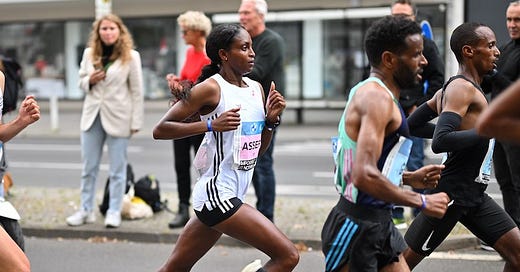





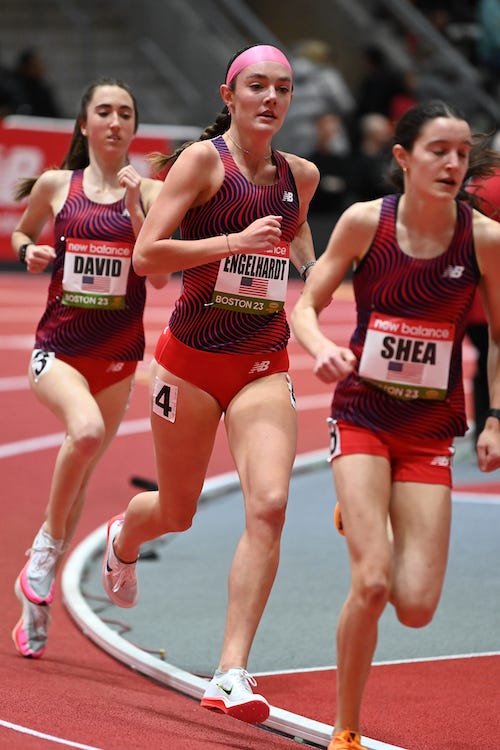





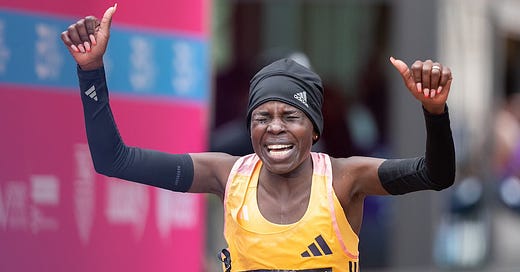

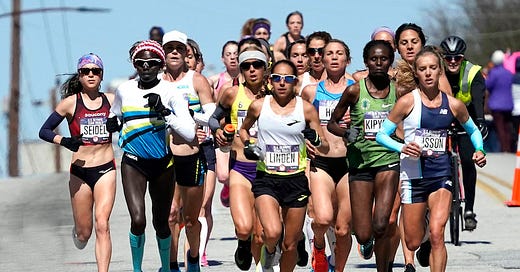

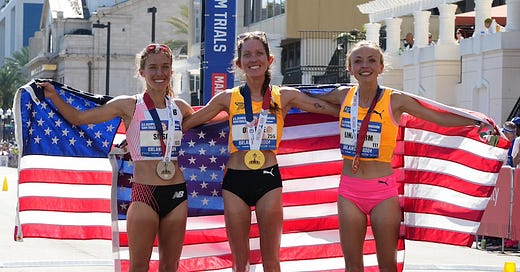

Great newsletter this week, as always. Thanks Alison.
thanks, as always, for your work. regarding "Tigist" vs "Tigst" Assefa, it would be "ትግስት" in the Fidel (the Ethiopian syllabary) if I'm correct. the respective characters reflect the sounds "ti," "gi,"si," "ti." so, it just depends on one's preference in the process of transliteration. whatever the spelling choice, she is one fast woman.